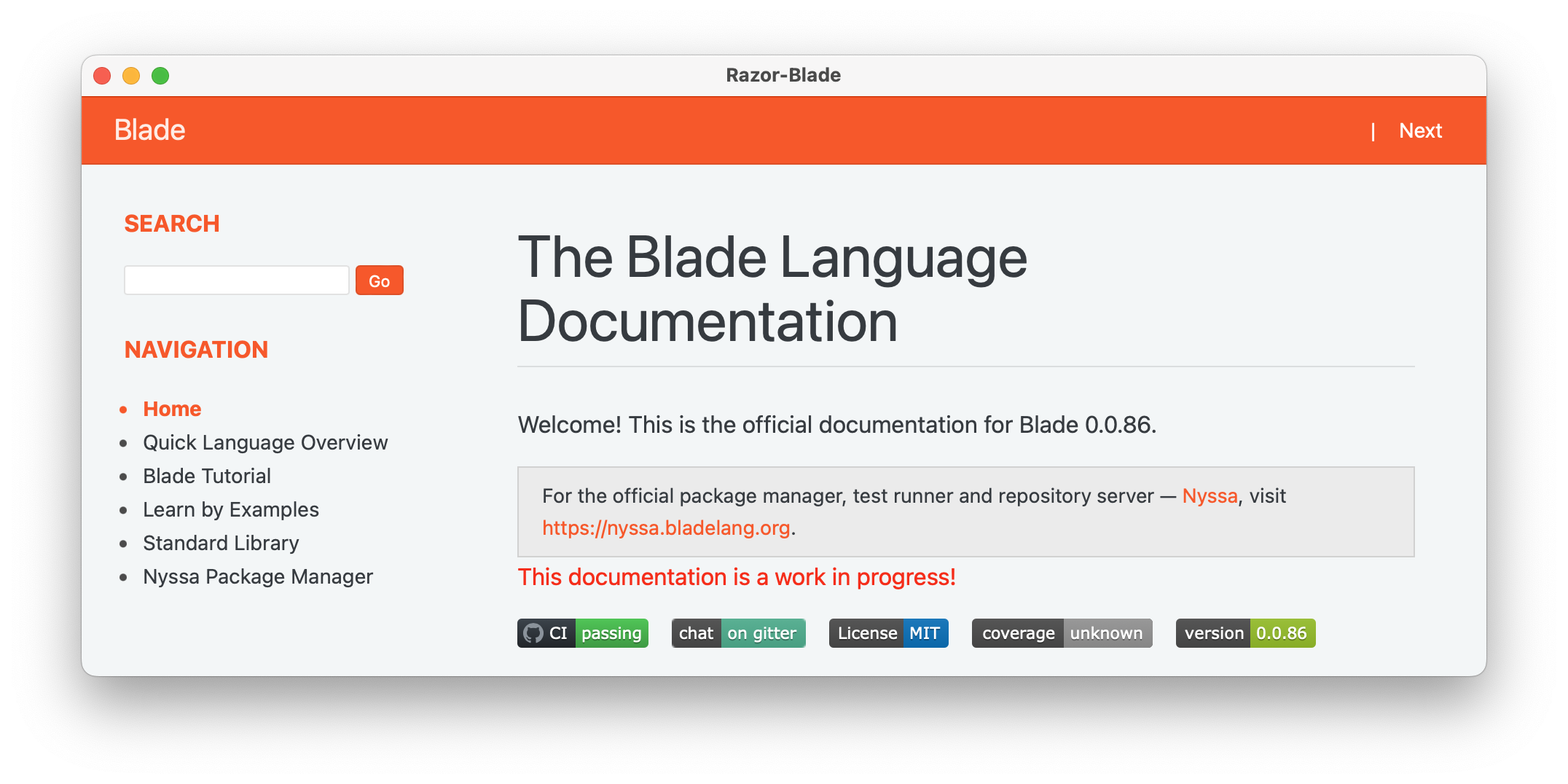razor
Webview bindings for Blade for build modern cross-platform GUIs.

Installation
You can install the package via Nyssa:
nyssa install razor
Or like any Blade package, you can download it and extract it into <PROJECT_ROOT>/.blade/libs/ directory.
Support
This library comes with pre-built webview binaries for the following platforms:
Linux: aarch64, arm, i386 (x64), and amd64 (x86_64)MacOS: aarch64 (M1, M2...), and amd64 (x86_64 - Intel)Windows: x86, x64 (x86_64)
Usage
-
Import the Razor module
import razor -
Create a new Razor instance
var app = Razor()You can also set the window size and/or whether to enable debug or not.
var app = Razor(640, 480, true)The above example sets the width to 640, height to 480, and enables debugging. You can set any of them to
nilto enable the default.By default, the width is
480and height is320while debug is disabled by default. -
Set url, title, etc.
app.set_title('Blade Browser'). set_size(480, 320, HINT_NONE). navigate('https://bladelang.org')Functions are chaninable except functions expected to return a value (getters) such as
get_window().See below for a list of all functions.
-
Run the webview
app.run()
Calling Blade functions from JavaScript
To call a Blade function from JS, you need to first bind the function. The example below binds the Blade
function reply allowing the JS code to call it.
app.bind('reply', @(args) {
echo args
return args
})
And then in HTML/JS,
<center>Hello World</center>
<script>
async function test() {
document.querySelector("center").innerHTML = (await reply("Hello Again"))
}
test()
</script>
NOTE: Blade functions are asynchronous in JS.
Running JS code from Blade
Use the eval() function to run JS code from Blade. For example,
app.eval("console.log('It works!')")
Api Documentation
class Razor
class Razor implements and exposes the WebView interface.
@constructor(width, height, debug)
Creates a new Razor instance.
- @param number? width - The width of the window (optional) - Default: 480
- @param number? height - The height of the window (optional) - Default: 320
- @param bool debug - Enable developer tools if supported by the backend.
destroy()
Destroys a webview instance and closes the window.
- @returns self
run()
Runs the main loop until it's terminated.
- @returns self
terminate()
Stops the main loop. It is safe to call this function from another other background thread.
- @returns
get_window()
Returns the native handle of the window associated with the webview instance.
The handle can be a GtkWindow pointer (GTK), NSWindow pointer (Cocoa)
or HWND (Win32).
- @returns ptr - The handle of the native window.
set_title(title)
Updates the title of the native window.
- @param string title - The new title.
- @returns self
set_size(width, height, hints)
Updates the size of the native window.
Remarks:
-
Using
HINT_MAXfor setting the maximum window size is not supported with GTK 4 because X11-specific functions such as gtk_window_set_geometry_hints were removed. This option has no effect when using GTK 4. -
@param number width - New width.
-
@param number? height - New height (optional) - Default: 320.
-
@param number? hints - Size hints (Optional - One of more of HINT_ constants) - Default:
HINT_NONE. -
@returns self
navigate(url)
Navigates razor to the given URL. URL may be a properly encoded data URI.
Example:
razor.navigate('https://github.com/webview/webview');
razor.navigate('data:text/html,%3Ch1%3EHello%3C%2Fh1%3E');
razor.navigate('data:text/html;base64,PGgxPkhlbGxvPC9oMT4=');
- @param string url - URL.
- @returns self
set_html(html)
Load HTML content into the razor.
Example:
razor.set_html(w, "<h1>Hello</h1>");
- @param string html - HTML content.
- @returns
load_file(path)
Loads a file into razor.
- @params string path - File path.
- @returns self
init(js)
Injects JavaScript code to be executed immediately upon loading a page.
The code will be executed before window.onload.
- @param string js - JS content.
- @returns self
eval(js)
Evaluates arbitrary JavaScript code.
Use bindings if you need to communicate the result of the evaluation.
- @param string js - JS content.
- @returns self
bind(name, callback)
Binds a function pointer to a new global JavaScript function.
Internally, JS glue code is injected to create the JS function by the given name. The callback function is passed the request from JS as a JSON object (which means it can be one of nil, boolean, string, list or dictionary).
- @param string name - Name of the JS function.
- @param function callback - Callback function.
- @returns self
unbind(name)
Removes a binding created with bind().
- @param string name - Name of the binding.
- @returns self
Contribution
All suggestions, pull requests, issues, discussions and other contributions are welcome and appreciated.
Contributors